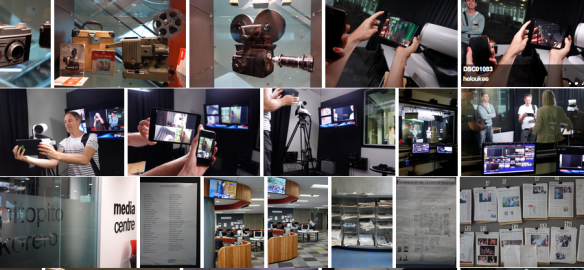ASCILITE (SYDNEY): After an intense week of #marmw2013 (mobile augmented reality movie workshops), it was a 5am Saturday start as myself Thom Cochrane and Laurent Antonczak flew to Sydney to deliver a condensed version of our Mobile and Augmented Reality Film Workshop at the Ascilite conference. Planning the session was in itself a useful exercise as it forced us to trim the workshop right down, sticking to the main points and activities.
In yet another ‘incredible shrinking world’ moment, the first people we bumped into at Ascilite were some of the Canberra team (big yay!), and it was great to have Cyntia Franco at our workshop. Cyntia’s into digital art installations and sailing around the world… i.e. awesomes.
Huge thanks to all of our workshop participants who were happy to get hands-on straight away and engaged in discussion and debate throughout – topics ranging from identity and ethics through to transmedia practices and geocaching. To finish off the workshop we all headed down to the local station, which had a rather striking set of escalators with a lift/elevator running down the middle: quite the Metropolis feel. Using Vyclone, we positioned ourselves on escalators, concourses and the lift and got to work. Rather pleased with the finished product (WE MADE ART GODDAMIT!) – example of rapid co-creation – and filters – which you can see here. Vyclone seem to like it too.
MASSEY UNIVERSITY (WELLINGTON): The following morning it was another early start (4.30am this time – my bodyclock is getting really screwed…) to fly back over to NZ: Massey University in Wellington – or Wellywood as it’s also known. Often referred to as one of the world’s coolest cities, it’s easy to see why – it’s colourful, quirky and oozes creativity. I was fortunate to be there on an unusually sunny/hot/calm day (Welington’s notorious for gale-force winds and earth tremors), but liked the vibe of the place straight away.
I was visiting the College of Creative Arts at Massey’s Wellington Campus – highlights included seeing a plasma proton gun, meeting up with Antony Nevin and finding out more about his work, learning more about Maori culture embedded in the currlculum, the fact that this is a campus with a high school in the middle, there’s a graffiti wall of fame on campus (used by kids for art projects), visiting the audio studios (felt like home)… and of course, seeing Max in his home environment. Max and the lovely Karen Curley gave me a whistle-stop tour of Welly in the evening before another early morning start – this time heading back up to Auckland for the last few days of our mobile and augmented reality film workshops.
(#marmw2013 – AUCKLAND): Over the past 5 days, workshop participants back in Auckland had been working on their personal #marmw2013 projects so these were the main focus for the rest of the week. Projects ranged from geo-located mobile-mentary through to new forms of engagement with architecture and interactive video applications. Dave Cowland did an excellent job of demonstrating how one device can be used to engage with architecture in different ways through media-rich POIs on an interactive map. Troy Egan had made a film based on the Augmented Reality Game INGRESS, which gave us a genuine insider view into the world of Ingress players in action. This actually made a wonderful complement to Candy Elsmore’s presentation at MINA – although bizarrely Troy wasn’t at MINA and wasn’t aware of Candy’s presentation. His inspiration for the film came from seeing a group of people acting strangely with their phones at a station and asking them what they were doing. SPOOKY – and yet more incredible shrinking world syndrome/serendipity/synchronicity. This was an ambitious project, giving us not only a rich insider perspective on INGRESS gameplay, but also touching on game addiction, game mechanics, identity play, social capital and communities dynamics.
Although I’ve only highlighted a couple of examples here, one of the most interesting developments (for me) has been seeing the way participants went in completely different directions when they went away to work on their personal projects. These individual interpretations and applications of mobile AR film across multiple contexts perfectly demonstrates the potential for media-rich, engaging, mobile AR across the curriculum. I’d love to have one more week (or more!), so that we could bring all participants together again to collaborate on a major project – after seeing their individual work and convening for group reflections/feedback, the potential for multidisciplinary teamwork is becoming increasingly apparent…




